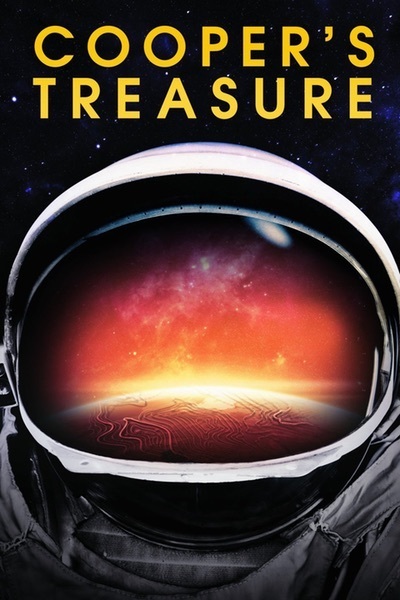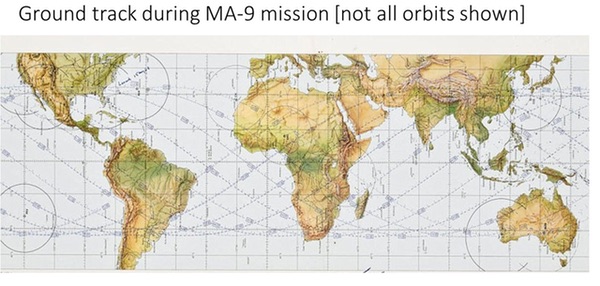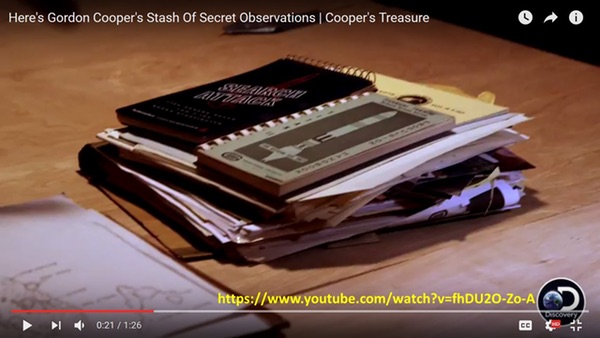25.04.2017

As any film buff can tell you, a “MacGuffin” is a plot device that is the focus of the drama and action of the story. It’s often a physical object, such as a codebook, or treasure map, that the protagonists are seeking.
| Specifically, reports Miklos, Cooper told him he found the potential treasure spots using a secret military sensor that had been installed on the spacecraft. |
For the Discovery Channel and its latest series, “Cooper’s Treasure,” there is indeed a treasure map, already in possession of a veteran “treasure hunter.” What makes this map unique, according to the program promos, is that it came from outer space.
Supposedly, Mercury astronaut Gordon Cooper made the map based on observations he made during his MA-9 orbital flight in May 1963. Near the end of his life, he shared the map and the research he’s been doing with a friend, Darrell Miklos, who vowed to complete Cooper’s search for shipwrecks full of gold.
Specifically, reports Miklos, Cooper told him he found the potential treasure spots using a secret military sensor that had been installed on the spacecraft originally to hunt for Soviet nuclear missile bases hidden in the area of Cuba—where a major international crisis involving such missiles had occurred only a few months before the flight.
“They were utilizing some kind of long-range detection equipment to look for nuclear threats,” Miklos told Fox News. “With that, his acute vision [and] possible cameras, he started identifying things that looked like shipwreck material. Once he had written all the coordinates down, he went back to Earth and put together this incredible treasure map from space on a sea chart.”
And that “secret sensor” may be the real MacGuffin of this tale, especially the quest by Miklos to prove that it was real, and hence that Cooper’s story was accurate. This object is the absolute key to the entire scenario, and without it, everything else collapses.
This makes this story a spaceflight history story, because the quest to uncover the degree of military activity within the NASA programs has been a legitimate and fertile field of investigation for decades, by numerous talented specialists. Nobody can guarantee there aren’t more such unearthly secrets yet to be unearthed.
Miklos asserts he’s found the proof, or at least, established that it wasn’t impossible. In terms of evidence, he has admitted that from the start he “believed Gordon 100 percent” and “didn’t need proof,” but some viewers might—and the host channel and program sponsors certainly would.
Considering the range of tales Cooper in those years was already telling, and writing for his autobiography Leap of Faith, the tale of a secret military sensor and hidden data that he copied, and “anomalies” his sharp eyes spotted out the window, is not out of character at all.
| The very idea such a sensor existed in that time period is preposterous. |
For Miklos, the favored explanation is that the device was installed on MA-9, aka Faith 7, secretly, in place of the periscope that had been taken off. In Episode 1 he discussed this theory with a group of long-retired spacecraft engineers from McDonnell in St. Louis, who had helped build the Mercury spacecraft. To a man, they stated that they had never heard of such a secret sensor, but at least agreed (as shown in the quoted excerpts) that it was possible it was installed where the periscope had been.

A map of ground tracks from the missions showed the limited opportunities for Cooper to observe the Caribbean.
|
Miklos explained that he asked the veterans because he was sure “NASA wouldn’t tell me.” Aside from the gratuitous slur on the openness of NASA’s manned space program, the comment might also be interpreted as meaning that NASA wouldn’t tell him what he wanted to hear. And he would have been right.
What any NASA official or competent space historian would have told Miklos was that the periscope and other gear was removed to make room for more supplies needed for the much longer mission of MA-9. This was directly addressed in an online NASA document:
“A number of alterations were made to the MA-9 spacecraft, most of them due to the extended duration of the flight. Among these were the increased capacity of several life support system components (additional oxygen and water, increased urine and condensate capacity, etc.), a larger capacity fuel tank, and larger capacity batteries (two 3,000 W-hour vs. two 1,500 W-hour). Deleted from the flight, due to weight considerations, were several backup or other components deemed unnecessary. These included the periscope, the backup UHF voice transmitter, the rate control system, and the backup telemetry transmitter. Also installed was a slow-scan television unit for in-flight evaluation in monitoring the astronaut and instruments.”
Another NASA veteran pointed out that the periscope had become redundant because a large window had been installed.
Since the periscope had been removed to save weight, anything going into the space it had occupied would have had to weigh nothing. More to the point, any new instrument would have needed some power and cooling, display and command interface with the astronaut, and the training and documentation needed to support that. If special orientation was needed, the spacecraft would have to turn as desired. Any standalone transmitters would need thorough vetting to protect from radiofrequency interference to and from the rest of the spacecraft.
Even the Mercury veterans that Miklos consulted indicated no knowledge of such secondary features. So the very idea such a device existed in that time period is preposterous.
In the bigger picture, any pressing justification for the alleged capability the device exclusively offered is also impossible to find. The spacecraft only orbited between 32 degrees latitude north and south, and all that airspace was fully-accessible to heavily instrumented airborne sensors already in the US inventory. Highly-capable US military spacecraft were routinely flying in orbit, able to carry such sensor systems, if they even existed. No Soviet nuclear missile sites in that near-equatorial band were ever found by any means.
The Miklos narrative of the “secret sensor” is that it operated in tandem with eyeball observations by Cooper and with photographs he took. Yet in 1963 nobody knew how good—if at all—eyeball observations were going to be. And if eyeballs were needed, the spacecraft would need to be put in special nose-down orientation and held that way, leaving unmistakable scheduling footprints.
Cooper’s photographic duties were also misrepresented by the program. In Episode 1, Miklos proclaims that Cooper took thousands of photographs. To back this up, the program plays an alleged clip of air-to-ground conversation where Cooper is quoted as saying “Man, all I do is take pictures, pictures, pictures. I’m up to 5,245 now,” a comment repeated on numerous news media descriptions of the program, including ABC News.
The pictures-pictures-pictures lament occurred at Mission Elapsed Time (MET) 25 hours, 12 minutes, 22 seconds, and can be found on the official transcripts. But oddly, the comment on five thousand odd shots does not appear there.
That comment can be found 44 minutes earlier in the sequence, where Cooper is taking time exposures of the horizon glow and zodiacal light (obviously at night), and having to count to 30 again and again to manually trigger the open-close of the camera aperture. After about 20 minutes of that he got giggly with the Capcom at the Cape, bantering, “I’m busy taking all these picture sequences, counting one, two, buckle my shoe type thing. Ha, ha! I’m up to five thousand two hundred forty four now. Ha, ha! Five, six, seven, eight, nine…”
As anyone who consults the original transcript can verify, this comment was made at 24 hours 28 minutes 26 seconds, and was clearly clipped out by some sound editor and then transposed to the end of another sentence Cooper hadn’t even said yet.
NASA records show that Cooper took several dozen photographs (not several thousand), with none reported over the Caribbean. That extremely small number, by delicious irony, is confirmed by a document Miklos himself gleefully waved at the camera in one scene where he shows the stack of research that Cooper had done on the maps.

Among the evidence for the map reportedly compiled for the show is a NASA report that states Cooper took no images of the Caribbean.
|
The report’s index number is clearly visible: NASA TN D-1868. “A Review of Photography of Earth From sounding Rockets and Satellites,” by Paul Lowman. Table 1 lists successful space photography flights, of which MA-9 was the latest. Regions photographed are: “Central, Philippine Islands, Pacific Ocean, Middle East, North Africa.”
| If there’s any wild space goose hunting going on, it’s plausible that Cooper’s own stories started it—and it wouldn’t be the first time. |
The report went on: “Cooper… took 29 color pictures of the Earth, as opportunity permitted… This was the most successful series taken during project Mercury, despite the fact that neither time nor attitude control fuel was specifically allotted for photography (all the pictures were taken during drifting flight).” Any consideration of Cooper looking at specific ground targets with or without guidance from a secret sensor has to recognize that to economize on fuel, Faith-7 was almost always in drifting flight; that is, no selected orientation in space. The narrow view out the small forward window pointed randomly around the sky and ground.
This random drift directly addresses another claim made by the program, that Cooper noticed “anomalies” and then wrote down their latitude and longitude. There is no explanation for how this would be possible in 1963; it’s even a challenge today. Being lucky enough to see a small island pass by and recognizing it—something that took full-time photoanalysts on Earth years of study to learn how to do—doesn’t wash, either. This feature of the story also has to go in the “impossible” column.
The report then goes on to note that “Cooper made a number of interesting observations on visibility and color…” and lists some specifics, including how he “noticed striking color differences in the water around islands in the Bahamas, which he attributed, presumably correctly, to water depth.” Lowman adds that this had already been studied from “conventional air photos” and suggests that “space photographs can also be used to map bottom topography,” but does not refer to any examples of these from Cooper’s flight.
And it’s not as if Cooper was crisscrossing Caribbean skies sightseeing. If the show is claiming that Cooper photographed the whole Caribbean area, it doesn't jibe with the actual flight path of the mission. Cooper only passed across the northern edge of the sunlit Caribbean on his fourth and 20th orbits (and a south pass Cozumel to Maracaibo on orbits 5 and 21.) He was busy with other stuff—as shown on the transcripts—on both the fourth and fifth orbits, when he explicitly described himself viewing the northern horizon, not nadir ground landmarks, and was doing deorbit preparations on the 20th and 21st orbits.
There’s plenty of time left in the series to explain many of these inconsistencies and inadequacies. If there’s any wild space goose hunting going on, it’s plausible that Cooper’s own stories started it—and it wouldn’t be the first time.
